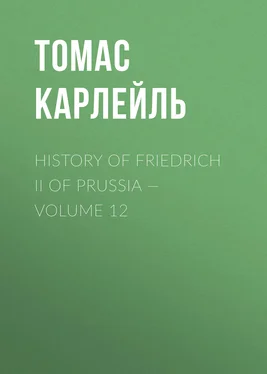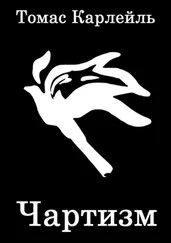Томас Карлейль - History of Friedrich II of Prussia — Volume 12
Здесь есть возможность читать онлайн «Томас Карлейль - History of Friedrich II of Prussia — Volume 12» — ознакомительный отрывок электронной книги совершенно бесплатно, а после прочтения отрывка купить полную версию. В некоторых случаях можно слушать аудио, скачать через торрент в формате fb2 и присутствует краткое содержание. Жанр: foreign_prose, История, literature_19, foreign_edu, foreign_antique, на английском языке. Описание произведения, (предисловие) а так же отзывы посетителей доступны на портале библиотеки ЛибКат.
- Название:History of Friedrich II of Prussia — Volume 12
- Автор:
- Жанр:
- Год:неизвестен
- ISBN:нет данных
- Рейтинг книги:3 / 5. Голосов: 1
-
Избранное:Добавить в избранное
- Отзывы:
-
Ваша оценка:
- 60
- 1
- 2
- 3
- 4
- 5
History of Friedrich II of Prussia — Volume 12: краткое содержание, описание и аннотация
Предлагаем к чтению аннотацию, описание, краткое содержание или предисловие (зависит от того, что написал сам автор книги «History of Friedrich II of Prussia — Volume 12»). Если вы не нашли необходимую информацию о книге — напишите в комментариях, мы постараемся отыскать её.
History of Friedrich II of Prussia — Volume 12 — читать онлайн ознакомительный отрывок
Ниже представлен текст книги, разбитый по страницам. Система сохранения места последней прочитанной страницы, позволяет с удобством читать онлайн бесплатно книгу «History of Friedrich II of Prussia — Volume 12», без необходимости каждый раз заново искать на чём Вы остановились. Поставьте закладку, и сможете в любой момент перейти на страницу, на которой закончили чтение.
Интервал:
Закладка:
Thomas Carlyle
History of Friedrich II of Prussia — Volume 12
BOOK XII. — FIRST SILESIAN WAR, AWAKENING A GENERAL EUROPEAN ONE, BEGINS. — December, 1740-May, 1741
Chapter I. — OF SCHLESIEN, OR SILESIA
Schlesien, what we call Silesia, lies in elliptic shape, spread on the top of Europe, partly girt with mountains, like the crown or crest to that part of the Earth;—highest table-land of Germany or of the Cisalpine Countries; and sending rivers into all the seas. The summit or highest level of it is in the southwest; longest diameter is from northwest to southeast. From Crossen, whither Friedrich is now driving, to the Jablunka Pass, which issues upon Hungary, is above 250 miles; the AXIS, therefore, or longest diameter, of our Ellipse we may call 230 English miles;—its shortest or conjugate diameter, from Friedland in Bohemia (Wallenstein's old Friedland), by Breslau across the Oder to the Polish Frontier, is about 100. The total area of Schlesien is counted to be some 20,000 square miles, nearly the third of England Proper.
Schlesien—will the reader learn to call it by that name, on occasion? for in these sad Manuscripts of ours the names alternate—is a fine, fertile, useful and beautiful Country. It leans sloping, as we hinted, to the East and to the North; a long curved buttress of Mountains ("RIESENGEBIRGE, Giant Mountains," is their best-known name in foreign countries) holding it up on the South and West sides. This Giant-Mountain Range,—which is a kind of continuation of the Saxon-Bohemian "Metal Mountains (ERZGEBIRGE)" and of the straggling Lausitz Mountains, to westward of these,—shapes itself like a bill-hook (or elliptically, as was said): handle and hook together may be some 200 miles in length. The precipitous side of this is, in general, turned outwards, towards Bohmen, Mahren, Ungarn (Bohemia, Moravia, Hungary, in our dialects); and Schlesien lies inside, irregularly sloping down, towards the Baltic and towards the utmost East, From the Bohemian side of these Mountains there rise two Rivers: Elbe, tending for the West; Morawa for the South;—Morawa, crossing Moravia, gets into the Donau, and thence into the Black-Sea; while Elbe, after intricate adventures among the mountains, and then prosperously across the plains, is out, with its many ships, into the Atlantic. Two rivers, we say, from the Bohemian or steep side: and again, from the Silesian side, there rise other two, the Oder and the Weichsel (VISTULA); which start pretty near one another in the Southeast, and, after wide windings, get both into the Baltic, at a good distance apart.
For the first thirty, or in parts, fifty miles from the Mountains, Silesia slopes somewhat rapidly; and is still to be called a Hill-country, rugged extensive elevations diversifying it: but after that, the slope is gentle, and at length insensible, or noticeable only by the way the waters run. From the central part of it, Schlesien pictures itself to you as a plain; growing ever flatter, ever sandier, as it abuts on the monotonous endless sand-flats of Poland, and the Brandenburg territories; nothing but Boundary Stones with their brass inscriptions marking where the transition is; and only some Fortified Town, not far off, keeping the door of the Country secure in that quarter.
On the other hand, the Mountain part of Schlesien is very picturesque; not of Alpine height anywhere (the Schnee-Koppe itself is under 5,000 feet), so that verdure and forest wood fail almost nowhere among the Mountains; and multiplex industry, besung by rushing torrents and the swift young rivers, nestles itself high up; and from wheat husbandry, madder and maize husbandry, to damask-weaving, metallurgy, charcoal-burning, tar-distillery, Schlesien has many trades, and has long been expert and busy at them to a high degree. A very pretty Ellipsis, or irregular Oval, on the summit of the European Continent;—"like the palm of a left hand well stretched out, with the Riesengebirge for thumb!" said a certain Herr to me, stretching out his arm in that fashion towards the northwest. Palm, well stretched out, measuring 250 miles; and the crossway 100. There are still beavers in Schlesien; the Katzbach River has gold grains in it, a kind of Pactolus not now worth working; and in the scraggy lonesome pine-woods, grimy individuals, with kindled mounds of pine-branches and smoke carefully kept down by sods, are sweating out a substance which they inform you is to be tar.
HISTORICAL EPOCHS OF SCHLESIEN;—AFTER THE QUADS AND MARCHMEN
Who first lived in Schlesien, or lived long since in it, there is no use in asking, nor in telling if one knew. "The QUADI and the Lygii," says Dryasdust, in a groping manner: Quadi and consorts, in the fifth or sixth Century, continues he with more confidence, shifted Rome-ward, following the general track of contemporaneous mankind; weak remnant of Quadi was thereupon overpowered by Slavic populations, and their Country became Polish, which the eastern rim of it still essentially is. That was the end of the Quadi in those parts, says History. But they cannot speak nor appeal for themselves; History has them much at discretion. Rude burial urns, with a handful of ashes in them, have been dug up in different places; these are all the Archives and Histories the Quadi now have. It appears their name signifies WICKED. They are those poor Quadi (WICKED PEOPLE) who always go along with the Marcomanni (MARCHMEN), in the bead-roll Histories one reads; and I almost guess they must have been of the same stock: "Wickeds and Borderers;" considered, on both sides of the Border, to belong to the Dangerous Classes in those times. Two things are certain: First, QUAD and its derivatives have, to this day, in the speech of rustic Germans, something of that meaning,—"nefarious," at least "injurious," "hateful, and to be avoided:" for example, QUADdel, "a nettle-burn;" QUETSchen, "to smash" (say, your thumb while hammering); &c. &c. And then a second thing: The Polish equivalent word is ZLE (Busching says ZLEXI); hence ZLEzien, SCHLEsien, meaning merely BADland, QUADland, what we might called DAMAGitia, or Country where you get into Trouble. That is the etymology, or what passes for such. As to the History of Schlesien, hitherwards of these burial urns dug up in different places, I notice, as not yet entirely buriable, Three Epochs.
FIRST EPOCH; CHRISTIANITY: A.D. 966. Introduction of Christianity; to the length of founding a Bishopric that year, so hopeful were the aspects; "Bishopric of Schmoger" (SchMAGram, dim little Village still discoverable on the Polish frontier, not far from the Town of Namslau); Bishopric which, after one removal farther inward, got across the Oder, to "WRUTISLAV," which me now call Breslau; and sticks there, as Bishopric of Breslau, to this day. Year 966: it was in Adalbert, our Prussian Saint and Missionary's younger time. Preaching, by zealous Polacks, must have been going on, while Adalbert, Bright in Nobleness, was studying at Magdeburg, and ripening for high things in the general estimation. This was a new gift from the Polacks, this of Christianity; an infinitely more important one than that nickname of "ZLEZIEN," or "DAMAGitia," stuck upon the poor Country, had been.
SECOND EPOCH; GET GRADUALLY CUT LOOSE FROM POLAND: A.D. 1139-1159. Twenty years of great trouble in Poland, which were of lasting benefit to Schlesien. In 1139 the Polack King, a very potent Majesty whom we could name but do not, died; and left his Dominions shared by punctual bequest among his five sons. Punctual bequest did avail: but the eldest Son (who was King, and had Schlesien with much else to his share) began to encroach, to grasp; upon which the others rose upon him, flung him out into exile; redivided; and hoped now they might have quiet. Hoped, but were disappointed; and could come to no sure bargain for the next twenty years,—not till "the eldest brother," first author of these strifes, "died an exile in Holstein," or was just about dying, and had agreed to take Schlesien for all claims, and be quiet thenceforth.
Читать дальшеИнтервал:
Закладка:
Похожие книги на «History of Friedrich II of Prussia — Volume 12»
Представляем Вашему вниманию похожие книги на «History of Friedrich II of Prussia — Volume 12» списком для выбора. Мы отобрали схожую по названию и смыслу литературу в надежде предоставить читателям больше вариантов отыскать новые, интересные, ещё непрочитанные произведения.
Обсуждение, отзывы о книге «History of Friedrich II of Prussia — Volume 12» и просто собственные мнения читателей. Оставьте ваши комментарии, напишите, что Вы думаете о произведении, его смысле или главных героях. Укажите что конкретно понравилось, а что нет, и почему Вы так считаете.









